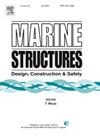基于多保真度代理模型的旋转式浮式起重机双驱动结构安全监测方法
IF 5.1
2区 工程技术
Q1 ENGINEERING, CIVIL
引用次数: 0
摘要
旋转浮式起重机(RFC)在海上起重作业中起着至关重要的作用,其运行安全性是重中之重。然而,在人工操作过程中,大的起重载荷和恶劣的条件下,可能导致姿势不稳定或结构失效,可能导致严重的经济损失和人身伤害。为了解决这些安全问题,对RFC操作进行全面监控至关重要。因此,本研究提出一种基于多保真度代理模型(MFSM)的数字孪生驱动结构安全监测方法。在实现过程中,参考实际RFC的结构和功能特点,构建RFC物理实体。在确定关键运行安全指标的基础上,开发了基于传感器的RFC实体数据采集模块。以实体为依托,进行有限元仿真和实际实验,生成RFC运行安全的多保真度训练数据,用于建立相应的mfsm。通过Unity3D引擎创建安全监测数据融合虚拟交互平台,实现RFC物理实体到DT模型的实时同步。最后,对RFC吊装作业进行了物理安全监测实验。实验结果表明,该方法具有较高的实时性和准确性,能有效满足RFC起重安全监控的工程要求。本文章由计算机程序翻译,如有差异,请以英文原文为准。
Digital twin-driven structure safety monitoring method for revolving floating cranes based on multi-fidelity surrogate models
The Revolving Floating Crane (RFC) plays a crucial role in offshore lifting operations, making its operational safety a top priority. However, large lifting loads and harsh conditions during manual operations can cause unstable postures or structural failures, potentially leading to serious economic losses and personal injuries. To address these safety concerns, comprehensive monitoring of RFC operations is essential. Thus, this study proposes a digital twin (DT)-driven structure safety monitoring method based on multi-fidelity surrogate model (MFSM). In the implementation, the structural and functional characteristics of actual RFCs are referenced to build an RFC physical entity. By identifying key operational safety indicators, a sensor-based data acquisition module for RFC entity is developed. Relying on the entity, finite element simulations and actual experiments are then conducted to generate multi-fidelity training data of RFC operational safety, which are used to establish corresponding MFSMs. By Unity3D engine, a virtual interaction platform for data fusion is created for safety monitoring, enabling real-time synchronization from the RFC physical entity to DT model. Finally, physical safety monitoring experiments are conducted on RFC lifting operations. Experiment results demonstrate that the proposed method delivers high real-time performance and accuracy, effectively meeting the engineering requirements for RFC lifting safety monitoring.
求助全文
通过发布文献求助,成功后即可免费获取论文全文。
去求助
来源期刊

Marine Structures
工程技术-工程:海洋
CiteScore
8.70
自引率
7.70%
发文量
157
审稿时长
6.4 months
期刊介绍:
This journal aims to provide a medium for presentation and discussion of the latest developments in research, design, fabrication and in-service experience relating to marine structures, i.e., all structures of steel, concrete, light alloy or composite construction having an interface with the sea, including ships, fixed and mobile offshore platforms, submarine and submersibles, pipelines, subsea systems for shallow and deep ocean operations and coastal structures such as piers.
 求助内容:
求助内容: 应助结果提醒方式:
应助结果提醒方式:


